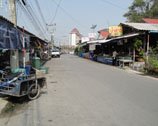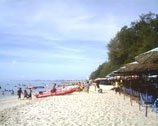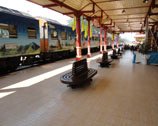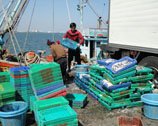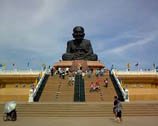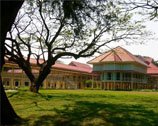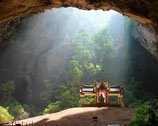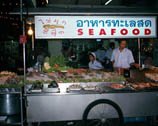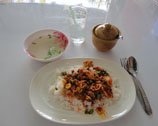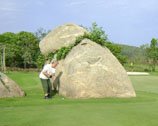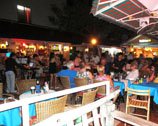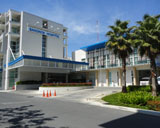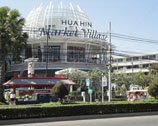THE AREA
Hua Hin
Hua Hin town in Prachuabkirikhan province is a popular beach resort approx. 200 kilometers south of Bangkok. Hua Hin, which literally means stone head in Thai, is the oldest beach resort of the country. Clean white sand, clear water and a tranquil atmosphere has continued to attract tourists in search of peaceful and relaxing holidays.
The making of the railway station in the reign of King Rama VI (1910-1925) and a summer palace by King Rama VII in 1926 transformed a quiet fishing village into an exciting resort town, which became very popular mainly among those from high society. The famous railway station is in the form of two magnificent pavilions, one of which is exclusively used by royalties visiting Hua Hin.
Today, Hua Hin is a well established beach destination with world-class facilities coupled with a true sense of Thai hospitality. Despite its expansive growth and development as a luxurious destination, the splendor of Hua Hin remains intact. Remaining content itself, Thailand’s oldest seaside resort has never sought international recognition. It has continued to provide a peaceful and relaxed sanctuary in a picturesque environment that comes with a true sense of historical identity.
Within a short distance of Hua Hin, a few of Thailand’s most well known national parks are located, the most popular being Kaeng Krachan and Sam Roi Yod. Both parks boast fabulous wildlife and nature and are easily accessible from Hua Hin. Khao Takiab - or the "monkey mountain", the summer palace in Petchaburi and the Praya Nakhorn Cave are also among the must-sees.
One of the many unique characters of Hua Hin is that its beach does not have any off shore islands to distract the panoramic view of the horizon. When the moon starts to slowly rise, the soft beam will shine directly to the beach. The best period to enjoy the romantic moon rise is during the cool season from October till March as the moon will rise just in front of Hua Hin beach. During this time the tide is also low after dark, which makes the beach a perfect place for a romantic walk.
Takiab
Five kilometers south of Hua Hin the small fishing village of Takiab is located. Early residents lead there lives here in their own pace, most of the community still depending on their daily catch from the sea to make a living. Some of the nicest and most well known seafood restaurants are found in this area - one of the best being Let’s Sea which is located next to Woraburi Resort. Takiab is slowly progressing from being a tranquil fishing village to a modern sea side resort with four- and five star hotels and condominiums and many international restaurants. Overshadowing the small village is Khao Takiab, or "The Monkey Mountain", home to a Thai-Chinese temple, nuns and monks and a pack of more or less tame monkeys. From here you’ll have a fantastic view over the Hua Hin bay area. At the foot of the mountain the local fishermen are harvesting their catch of fish, squids and crabs in the early hours of every morning.
One kilometer south of Takiab the nicest beach of the area is to be found. Even on a busy day you will spot very few visitors and you will have the waves and the sand practically for yourself. Have your lunch and your drinks in one of the small local restaurants on the beach and enjoy life.
Cha-Am
Cha-Am is another small fishing village located 25 kilometers north of Hua Hin. It has not yet grown to the resort size which its sister town has. If you want to experience the real taste of local Thai fishing culture, Cha-Am has plenty to offer in that aspect. As for its beach, it is beautiful and quiet and the sand is coarse and golden, and you will find plenty of shade underneath the pine trees that cover it.
Cha-Am has developed as a weekend beach resort for increasingly affluent Bangkokians, a quieter and more family oriented resort than Pattaya across the Gulf. Reflecting its popularity among Thais, Cha-Am emphasizes good food and drink, especially delicious sea food - prawns, fish, squid and mussels prepared simply in beach side bars and cafes or elaborately in more formal hotels and restaurants. The weekend is party time, when people visit from Bangkok.
Mid-week gives opportunity for more peaceful relaxation with lots of sandy beach which stretch to Hua Hin, dotted with deluxe and luxury resorts along the way. Cha-Am is also within easy distance of the historic city of Phetchaburi, the famous Damnoen Saduak floating market and the natural wonders of Kaeng Krachan National Park’s unspoilt forest and Sam Roi Yot National Park’s spectacular bird life.
HISTORY
Since the Southern Railroad was constructed, shortly after World War I, to give people opportunities to travel overland all the way to the Malaysian border, the beach of Hua Hin has enjoyed a solid reputation as "the famous seaside resort of Siam" where visitors could enjoy swimming, fishing and golfing on the country’s first standard course Hua Hin Royal Golf Course (1927) during the weekends.
Hua Hin’s rise came with the opening of the Railway Hotel (Hotel Sofitel Centara), after the Southern line was completed. It was an elegant Victorian structure on the shore with vast rooms, private veranda, fancy fretwork decoration and wickerwork chairs in the lounge. Soon afterwards a first complex of bungalows (Centara Sofitel Grand Resort & Villas) was built together with a Victorian-style gazebo on a scenic group of rocks near Hua Hin Village, and this place, later, was selected as a venue in the film "The Devil’s Paradise", as well as the Railway Hotel, which portrayed Phnom Penh’s leading hotel in the hectic days just before the city’s fall in the film "Killing Fields".
Nowadays, among the developments of the world, Hua Hin’s pleasures are still placid, not all that different, indeed, from those enjoyed by the aristocratic visitors of its past. That’s Hua Hin - the oldest beach resort of Siam, with a sense of history and a peaceful but scenic atmosphere.
ATTRACTIONS
The Railway Station
Built in the reign of Rama VI (1910-1925), this Railway Station was designed with delicate taste in the classic Hua Hin architecture style. It comprises two magnificent white pavilions, one of which is exclusi-vely used by visiting royalties. A charming and picturesque station well worth a few snap shots! And, by the way, the famous Oriental Express still runs through Hua Hin on its journey down south to reach Singapore! Check-out the time table.
Sofitel Centara Hua Hin Resort
With 13 hectares of private landscaped gardens, the resorts giant green topiaries have been artistically trimmed and shaped to add to the hotel’s splendor. Sofitel Centara Hua Hin resort has a unique old-world charm that reflects how "old Siam" used to be. Considered as one of Southeast Asia’s most romantic hotels, this luxurious resort offers charming colonial-era architecture with teak work furnishings of the superbly maintained guestrooms and suites, which date back to 1923.
Originally known as The Railway Hotel, the first class resort accommodated visitors to the King Rama VI´s summer palace. The location has also been used as a setting for Hollywood films; most notably the Oscar nominated "The Killing Fields".
Night Market
Open 7 days a week, the vendors are in full commerce from about 7 PM. The Night Market is a very interesting place where you can browse for souvenirs, clothing, handcrafts and all sorts. It is also a very good venue for excellent and very cheap sea food. You can find just about all kinds of dishes and it is a very good eye opener on where the locals get to meet every night! You can find yourself hovering through the market in 15 minutes or three hours depending on your interest and mood. No matter how long you’ve got to spend in the market you’ll surely find the walk somewhat interesting.
Fishing Pier
A very exciting and interesting outing is to visit the fishing pier and watch the fishermen unload their catch. It is a fine way to really taste the real root of Hua Hin as it started out as a fishing village. And you might, as a matter of fact, see your forth-coming sea food dinner arrive there at the spot. Fresher than this is hard to beat!
Temple
Many temples can be found in- and outside Hua Hin. All visitors are welcome. Just remember to follow the rules in the temple. No shoes are allowed and shorts and sleeveless T-shirts are not accepted in most. As a visitor in Thailand one should always show the same respect for traditions and personal behavior as the Thais do.
Wat Huay Mongkol
This Buddhist temple is home to the world’s largest statue of Luang Phor Thuad, a legendary southern Thai monk revered for his enlighten-ment and ability to perform miracles. Many believe that the amulets created in his image guarantee safety in times of distress. The statue, set within a park-like setting that attracts many visitors each weekend, was commissioned by HM Queen Sirikit. Sitting in the meditation pose, it looms overhead once you arrive on the worship ground.
Mrigadayavan Palace
The Summer Palace is situated between Cha-Am and Pranbury. It consists of 16 buildings divided into three groups. The groups are connected with covered verandas on stilts. It was Kung Rama VI: summer residence from the completion 1923 until his death 1925. The following King built a new palace in Hua Hin, Klai Kangwon Palace (“far from worries”) and Mrigadayavan Palce fell into decay until the present HMK Bhumibol (Rama IX) decided on a restoration 1983.
Kaeng Krachan National Park
Covers 2,920 sq. kilometers of sub mountain and tropical broad-leaved evergreen forest with some lowland scrub and mixed deciduous forest. The area is next to sparsely populated forests in Myanmar (Burma) with hills rising to 1.200 m. It is Thailand’s largest national park and was established in 1981 with the wishes of His Majesty the King to protect the vital watershed. Though insufficient research has been done it is clear that the park offers refuge to a great variety of wildlife in some of the healthiest tracts of forest left in the country. The number of mammal species, including elephant, tiger, leopard, clouded leopard and Asiatic black bear. The park is one of the most important bird watching sites and over 250 bird species have been confirmed. Karen tribesmen, living in the park, even claim they have spotted Sumatran rhinoceros, one of Asia’s shyest and rarest animals.
One of the park’s main attractions is the Pa La-u waterfalls which cascades down 11 tiers of rocks and is an area with large numbers of resting areas. The Kaeng Krachan Dam across the Phetchaburi river, completed in 1966, has a scenic reservoir with 45 sq. kilometers of lake and islands set amidst the forest covered mountains, a place for boat trips.
Ecologically sensitive trekking, including special treks in search of birds or butterflies and rafting on the Phetchaburi river, is being promoted in a controlled manner to preserve the park. Access and the wildlife mean guides are a must and most of them are friendly, able and speaks some English.
Khao Sam Roi Yot National Park
This is one of the smallest national parks but is also one of the most important. Khao Sam Roi Yot - the mountain with 300 peaks - is a spec-tacular limestone mountain dotted with dwarf evergreen trees on the high, steep slopes and denser, mixed deciduous forest on the lower slopes.
The park is definitely a paradise for bird watchers. Some 275 bird species have been confirmed including many of the ones very rarely seen in Asia. The park headquarters has information and guides for bird watching and there are trails to hide for bird watching.
There are trails for hiking and biking along the coast and up the mountain - for superb views along the coast - and many caves in the lime-stone, including Sai And Kaew caves with large stalactites and stalagmites.
The most famous cave in the park is Tham Phraya Nakhon. The cave is named after Chao Phraya Nakhon who took refuge in the cave in a storm - he was ruler of Nakhon Sri Thammarat, on the Gulf Coast, at the time of the foundation of Bangkok. It is a huge and fascinating cave with a big hole through which a shaft of light illuminates the cave and permits the growth of various plants.
There is food and simple accommodation in the park, but it can easily be reached from Hua Hin. It is useful to remember that swamps and mud flats are short of shade but quite rich in flying insects, such as mosquitoes. Sun cream, hat or shade and insect repellent is a good idea.
WHAT TO DO
Eating and Drinking
Hua Hin offers a large number of small Thai restau-rants and street stalls that serve delicious Thai dishes at very reasonable prices. You can have your mild or spicy rice dish with some meat for less than a euro. In the international town centre you will find restaurants from all parts of the world. Italian, French, Scandinavian, American, Chinese, Japanese, Indian, Mexican - you name it! And along the water front the sea food restaurants are situated shoulder to shoulder. In the town centre you don’t have to look for long to find a place that serves an English breakfast. If you want to bring the taste of the Thai cuisine home to your own dining table you can attend one of the Thai cooking lessons offered.
In recent years many evening markets for eating and drinking have mushroomed. Well worth a visit is the Cicada/Tamarind Market on the road to Takieb. It is a week end market which also offers live music.
Eating by the curb
Whether you stop for a hamburger in your local street kitchen or not, there is no reason not to do the same at the Thai equivalent. Eating at road sides is big in Thailand. You can see it everywhere, from the crowded streets of Bangkok to the remote clay roads in the country side. Most of the times it is not only very cheap, but also astonishing tasty. But, you may ask, is it safe to eat there? ABSOLUTELY!
Food poisoning is very rare, and more often hits people persisting in ordering "farang" (foreign) food in Thailand. Thai food includes a lot of vegetables and the favorite above others is Som Tam Thai, a salad which is made on a base of papaya. Add some baby tomatoes, a cup of dried shrimps, some roasted peanuts, palm sugar, a squeeze of lime, a teaspoon of fish sauce and as much hot chili as you can take. All is mixed into a mortar and grinded into a juicy salad. Enjoy with a bowl of rice or noodles.
Gai Yang is a chicken dish roasted on a big spit. The meat is marinated in a spicy but not too hot sauce. A hot dip sauce in a plastic bag goes with it. And of course the ever present rice or noodles. Pla Muek Yang is grilled squid that comes in two typical fashions. One is made from squids of about 10 centimeters grilled on a roast. The other is made from dried squids cut into stripes or chips, quickly boiled in oil and served with a dip sauce.
Pat Kapao Gai, Kai Dao, Lat Kao are typical every day dishes in Thailand. Pieces of chicken fried with leaves of basilica, chili, garlic a fried egg, all served with rice or noodles. If you prefer pork, change "gaij" for "moo". A common noodle dish with white noodles is "goej tio". If you look at a side street in Bangkok around lunch time you can see masses of well dressed people slurping "goej tio" at the sheet metal tables. The soup bowl can consist of a lot of things, but you do not have to take all. Just make your own selection among the offered ingredients.
Seasoning is always a matter of taste. Someone who is not used to Thai food may find it hot in the beginning. Do not add extra spices until you have tasted. Salt is not used very much at the table. Instead the Thais use fish sauce "nam pla", often enriched with chili and lime. Noodle dishes you season as you like with "four Thai spices": sugar, dried chili, fish sauce and wine vinegar.
Beverage is up to you, but water, ice tea or beer goes well with these dishes. Why not try the local beers, Singha or Tiger? In the evenings the Thais often drink Thai whisky and soda with their street kitchen food. A small amount of whisky and lots of soda. Price depends on the class of the kitchen, but you can have an excellent taste sensation for less than a euro. Many establishments have signs in English, so you do not have to feel helpless if you do not understand Thai. But the old saying that a smile goes a long way works very well everywhere.
Shopping
The main shopping venues are Market Village and
Blúport which both offer a great number of brand
shops, vendor stalls, short time markets and
department stores. The old Hua Hin shopping mall
has had a face lift and has among other things a
well-stocked grocery store. Villa Market has a
good selection of imported food products in its
two outlets, next to San Paolo Hospital and Index
shopping mall (furniture). Big C supermarket is located on the road to Pa La-U waterfalls. Top's has opened on the corner of Petchkasem Road and soi 88.
Cinema
Market Villa and Blúport offer, among a great number of restaurants, boutiques and big food stores also cinemas that run movies from mid day to late night, some in English with subtitles in Thai.
Roller skating
The entertainment area on the top floor in Market Village offers, apart from all kind of games, also a roller skate rink.
Lawn bowls
Lawn bowls is a precision sport belonging to the boules game family. It is played on turf or an artificial surface as artificial grass. Thailand’s only artificial grass court is located in Hua Hin. Lawn bowls is played with asymmetric bowls of synthetic material with a diameter of approx. 5 inches. Because of the asymmetric body the bowls do not roll straight. You can choose from different bowls to get the roll curve you desire. The purpose is to roll the bowl as close to a small target ball, the “jack” as possible. Lawn Balls Hua Hin is located in Seajay Resort.
Golf
In and around Hua Hin you have a choice of ten different golf courses at affordable prices, most of them of Championship categories. Right next to the train station is The Royal Hua Hin GolfCourse, Thailand’s oldest, opened in 1927. The others are Springfield, Palm Hills, Majestic Creek, Lakeview, The Eagle Golf Club, Black Mountain and Banyan. Black Mountain and Banyan are constantly voted among the best and golf courses in South East Asia. A caddy is compulsory on all courses. If you don’t want to bring your own equipment it can be rented everywhere.
Elephant riding
There are a couple of elephant parks in and around Hua Hin. They are presenting daily shows and you will also have the opportunity to take a ride on one of these ancient working animals in Thailand. At Hua Hin Safari you can also watch a crocodile or snake show.
Floating Market
Sam Phan Nam floating market just outside Hua Hin, off soi 112. It has been created as a model of the well-known Damnoen Floating Market outside Bangkok. The Hua Hin floating market is more a tourist attraction than a place for shopping your daily grocery.
Water parks
The Black Mountain Water Park offers a 17 meter high tower from which you can chose between nine different sliders for your ride down to the pool. You may also dive into some high waves in the wave pool or slowly glide around on the lazy river. There is also an artificial beach pool, a fountain pool a kids’ pool and a pool bar. Other amenities include a restaurant and a shop. The water park is open daily from 10 AM to 5 PM. Those more daring may want to try their skills in the neighboring wakeboard park (water ski on “snowboard”). Vana Nava, Asia’s first Water Jungle, is located on the high-way just south of Hua Hin next to the new Holiday Inn. Claiming to be the first ecologically and community aware waterpark in the region, Vana Nava is a tropical jungle with over 200,000 living species from across Thailand. Nineteen very exciting rides and slides including the largest slide in Thailand, the Abyss, to the tallest man made mountain with waterfall in Asia, Vana Nava Falls, the park has it all.
Body care
Massage parlors and spas offer a wide selection of treatment. Thai-, oil-, foot-, aroma massage, facial treatments reflexology and so on. An hour or two in one of the establishments is well spent time for a small cost.
Fitness
True Arena offers a wide variety of sports including a well equipped gym, a 25 m pool and 10 tennis courts. @letic is a highly modern fitness center with all the up-to-date equipment for your well-being. They are located at soi 88 near Petchkasem Road. You may also want to visit H.M. The King’s palace park which is open for walkers/joggers a few hours in the mornings and afternoons.
Thai Boxing
This ancient sport, in many ways connected with the Buddhist traditions, is one of Thailand’s most popular attractions. Hua Hin has two major Thai boxing arenas. The Boxing Garden is located in the centre of town in the same area as Hotel City Beach and Grand Sport is located in front of Grand Hotel. Normally there are two show-nights per week in each place.
Night life
Yes, there is a night life in Hua Hin too. However not so eye catching as in Bangkok, Phuket or Pattaya. The beer bars along soi Binthabat and Poonsuk Road draw the usual suspects. Many bars in the entertainment centre offer live music. Jazz lovers can enjoy their kind of music in numerous small venues around town. A handful of hard rock clubs complete the selection of music tastes.
Gokart
One of the Gokart courts of the area is located in the northern part of Hua Hin. Check their webpage for opening hours, events and prices.
Media
English and international newspapers, magazines and books are sold in many places. You can also watch live English football and other sports on wide screens in many bars and pubs. Internet cafes you'll find in almost every street corner.
Hospitals
Hua Hin has three major hospitals and a red cross station. The newest one with the most up-to-date facilities is Bangkok Hospital on the south end of the main road which is a branch of the nationwide Bangkok Hospital network. San Paolo Hospital in the town center is well known by tourists over the years for their good medical capacity. The third, Hua Hin hospital, is located at the north end of the main road and is mainly used by local people. However, “farangs” are also welcome.
COMMUNICATION
If you want to pay a visit to Bangkok, with more than six million people you can either take a taxi for around 2.000 baht, the train, around 300 baht, or an A/C bus for 180 baht. You may also choose to go with a van which takes you in to the several places in Bangkok. Price for van is 180 baht and they operate all day from soi 51. There is also a direct airport bus between Hua Hin and Suvarnabhumi with several daily tours. Hua Hin airport has a daily flight connection with Kuala Lumpur, Malaysia, and Bangkok five days a week.
Get around
When you have had your fair amount of relaxing in the sun chair, maybe you want to visit other places in Thailand. Apart from he nearby National Parks and the wide streched beaches south of Hua Hin. Moonson Valley Vineyard 45 minutes west of Hua Hin has a nice restaurant with panoramiv views over the wineyard and the elephants carrying visitors around. Locally produced wine, some excellent,are on sale also. The River Kwai bridge needsno further presentation. But a one- or twoday trip to visit this historic landmark in Kanchanaburi is worth the effort.
Phuket or Pattaya may draw some interest too. Phuket can be reached by daily bus from Hua Hin Busterminal and Pattaya is reachable by a daily catamaran. If you have had enough of waterfront cities Chiang Mai in the north can be recommended. And of course, from Hua Hin it only takes a few hours to reach the never sleeping Bangkok.
And if you stay longer time in Thailand, why not take a trip to the world heritage Angkor Wat in Siem Reap in Cambodia, the magnificent 1000 years old temples in the jungle, rediscovered in 1866. Or follow Vietnam from north to south, from the communist influented Hanoi and the archipelago of Halong Bay in the north, through the old emperor city of Hue to the glittering Ho Chi Minh City (Saigon) in the south. If you don't suffer from claustrophobia a crawl through the Cu Chi tunnels is a memorable experience. All of the mentioned Vietnames cities show many ries from the Vietnam war. Or follow the Mekong River through the still from tourists much spared Laos.


